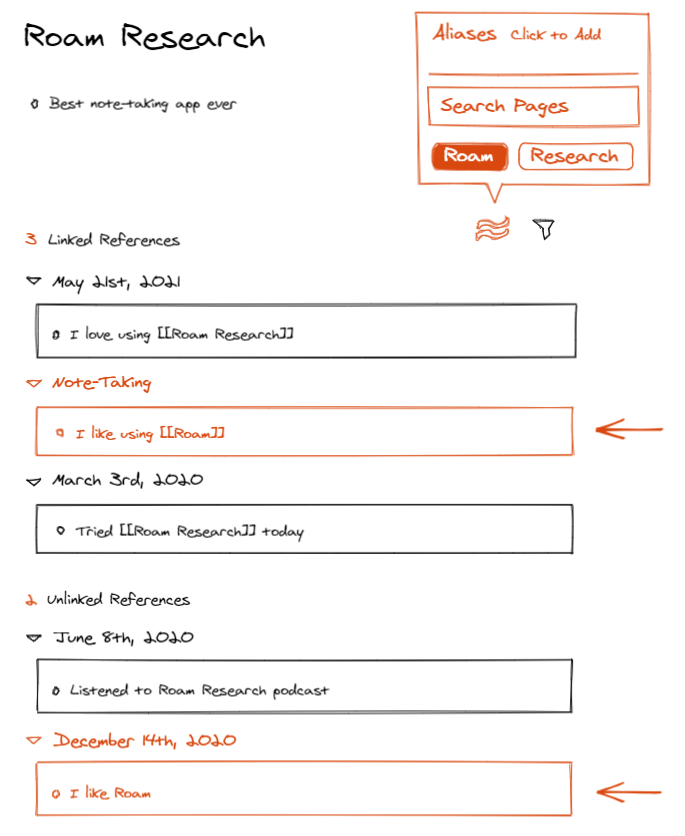
BARDIA I HAD A THOUGHT #Roam
https://twitter.com/thepericulum/status/1382186326368215045
Most of the time when I want to make two pages into aliases/synonyms, what am I *actually* trying to do?
I'm trying to say, "These two page titles *are* different (different enough not to rename to be identical), but for some purpose I'm TREATING THEM as the same."
I'm trying to say, "These two page titles *are* different (different enough not to rename to be identical), but for some purpose I'm TREATING THEM as the same."
In what context does it MATTER that two pages are associated that way?
I want to argue, it's NOT when I'm WRITING notes. That's not when aliasing matters.
Aliasing matters when I'm trying to resurface connections BETWEEN notes.
I want to argue, it's NOT when I'm WRITING notes. That's not when aliasing matters.
Aliasing matters when I'm trying to resurface connections BETWEEN notes.
Where/how does resurfacing happen in Roam?
Queries, Linked References, and Unlinked references (and to a lesser extent, [[]] autocomplete).
Queries, Linked References, and Unlinked references (and to a lesser extent, [[]] autocomplete).
In Queries, I can already write query syntax to accomplish functional aliasing—to logically treat two pages as equivalent, all I gotta do is replace a single page in the query (say, [[page 1]]) with an {or: [[page 1]] [[page a]]}.
Done. No need for a new feature here.
Done. No need for a new feature here.
So here's the big thought (are you ready for this):
+90% of the time when I think want to make two pages into "aliases," all I ACTUALLY need is a way to add an "OR" clause to the Linked and Unlinked References section of a page.
🤯
+90% of the time when I think want to make two pages into "aliases," all I ACTUALLY need is a way to add an "OR" clause to the Linked and Unlinked References section of a page.
🤯
This means that "aliasing" is EXACTLY THE SAME THING as "filtering," just using logical "OR" instead of logical "AND."
Full Outer Join rather than Inner Join.
Logical AND Logical OR
↓ ↓
Full Outer Join rather than Inner Join.
Logical AND Logical OR
↓ ↓

"Alias" should just be a type of filter—an INVERSE FILTER that *ADDS* links to the Linked References and Unlinked References lists, rather than removing stuff from them.
🤯🤯🤯
🤯🤯🤯
Here's how I would implement it:
Add a button next to the Filter button, right above Linked References.
It suggests pages that are textually similar to the main page, but with search bar to pick any page in the graph.
Click to add as many as you want, just like filters.
Add a button next to the Filter button, right above Linked References.
It suggests pages that are textually similar to the main page, but with search bar to pick any page in the graph.
Click to add as many as you want, just like filters.

Effect:
Aliased pages seamlessly populate in Linked and Unlinked References
Aliases added to one page auto-add to the corresponding page too
Maybe color code them as aliases, maybe not
Aliased pages seamlessly populate in Linked and Unlinked References
Aliases added to one page auto-add to the corresponding page too
Maybe color code them as aliases, maybe not

I think this would handle the overwhelming majority of use cases for "Aliasing" in a simple-to-implement, visually idiomatic way that requires no new primitives or fundamental changes to the core of how Roam works today.
It's SO simple, actually, this could probably be a Roam42 feature before ascending to true feature status.
@dvargas92495 @roamhacker
@dvargas92495 @roamhacker
• • •
Missing some Tweet in this thread? You can try to
force a refresh



